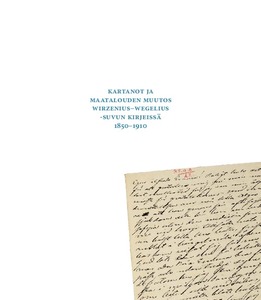Kartanot ja maatalouden muutos Wirzenius–Wegelius-suvun kirjeissä 1850–1910
Hietala, Elsa (2024-04-20)
Kartanot ja maatalouden muutos Wirzenius–Wegelius-suvun kirjeissä 1850–1910
Hietala, Elsa
(20.04.2024)
Suomen maatalousmuseo Sarka
Julkaisun pysyvä osoite on:
https://urn.fi/URN:ISBN:978-952-69213-5-8
https://urn.fi/URN:ISBN:978-952-69213-5-8
Kuvaus
ei tietoa saavutettavuudesta
Tiivistelmä
Väitöskirja tarkastelee kahden kartanon maatalouden kehitystä 1800-luvun jälkipuoliskolla kirjelähteiden avulla. Työn tarkoituksena on selvittää, miten maataloutta kartanoissa harjoitettiin ja kuinka tutkimusajankohtana koetut tieteen, teknologian ja yhteiskunnan muutokset siihen vaikuttivat. Keskeisiä tutkimuskohteita ovat perheen sisäinen roolijako sekä toisaalta työnteko ja -tekijät kartanotalouden erottamattomina osina. Tässä tutkimuksessa tarkastellaan myös tilojen kykyä selviytyä haastavista ajoista, kuten katovuosista ja sukupolvenvaihdoksista.
Maatalouden ja viljelijöiden kannalta 1800-luvun lopun merkittävimpänä muutoksena on pidetty tuotantosuunnan vaihtumista kasvinviljelypainotteisesta karjatalousvaltaiseen tuotantoon. Tässä tutkimuksessa maatalouden muutosta tutkitaan aikaisemmasta poiketen pääosin perhekirjeitä lähteenä käyttäen. Alkuperäisiä kirjanpitolähteitä ja tilastotietoja tutkimusjakson alkuvuosikymmeniltä on säilynyt vain vähän ja siksi on perusteltua lähestyä aihetta laadullisen tutkimuksen keinoin. Analysoinnin apuvälineenä on käytetty osin lähilukua ja osin laadullista sisällönanalyysiä.
Tutkimuksen lähteet antavat tietoa kartanon arjesta, jossa maatalouden edellytysten muuttuessa jokaisen viljelijän piti valita oma toimintatapansa.Työ avaa uudella tavalla, miten kartanon työnjaossa kaikki yksilöt olivat tärkeitä ja työnantajien ja -tekijöiden välillä tuli vallita luottamukseen perustuva yhteisymmärrys. Kartanoiden toiminnan kannalta työntekijät olivat elintärkeä voimavara. Uutta tutkimuksessa on myös kartanoiden leskiemäntien merkityksen huomioiminen taloudellisen tuotannon kehittäjinä. Sukutiloilla perhesuhteet vaikuttivat tilan tulevaisuuteen tähyäviin ratkaisuihin ja sukupolvenvaihdoksen onnistuminen saattoi olla tilan jatkumisen kannalta oleellinen tekijä. Country estates and the change in agriculture in letters of the Wirzenius-Wegelius family, 1850–1910
This doctoral dissertation examines the development of agriculture in two country estates in the latter half of the 19th century via letters of correspondence. The work aimed to study how agriculture was practised on country estates and how it was affected by the changes in science, technology and society during the researched period. Key research areas include the division of roles within the family and work and workers as inseparable elements of the economics of a country estate. This research also examines the resilience of country estates in challenging times, such as years of crop failures and changes of generation.
The transition from crop-oriented to livestock-dominated production is considered the most significant change in agriculture and farming in the late 19th century. Unlike previous research, this work mainly uses family letters as sources for studying the change in agriculture. Few sources remain of the original accounting sources and statistical data for the initial decades of the research period. Therefore, qualitative research is a justified approach to the topic. The analysis tools used included close reading and qualitative content analysis.
The sources for this research provide information about the everyday life on a country estate, where every farmer needed to choose a way of working as the preconditions for agriculture changed. The study reveals how every individual was important in the division of labour on a country estate and how employers and workers needed to reach an understanding based on trust. Workers were a vital resource for the operations of country estates. Another novel aspect of the study is its consideration of the importance of widows on country estates in developing economic production. On family estates, family relationships affected decisions about the estate’s future, and a successful hand-down to the next generation could be critical to the continuity of the estate.
Maatalouden ja viljelijöiden kannalta 1800-luvun lopun merkittävimpänä muutoksena on pidetty tuotantosuunnan vaihtumista kasvinviljelypainotteisesta karjatalousvaltaiseen tuotantoon. Tässä tutkimuksessa maatalouden muutosta tutkitaan aikaisemmasta poiketen pääosin perhekirjeitä lähteenä käyttäen. Alkuperäisiä kirjanpitolähteitä ja tilastotietoja tutkimusjakson alkuvuosikymmeniltä on säilynyt vain vähän ja siksi on perusteltua lähestyä aihetta laadullisen tutkimuksen keinoin. Analysoinnin apuvälineenä on käytetty osin lähilukua ja osin laadullista sisällönanalyysiä.
Tutkimuksen lähteet antavat tietoa kartanon arjesta, jossa maatalouden edellytysten muuttuessa jokaisen viljelijän piti valita oma toimintatapansa.Työ avaa uudella tavalla, miten kartanon työnjaossa kaikki yksilöt olivat tärkeitä ja työnantajien ja -tekijöiden välillä tuli vallita luottamukseen perustuva yhteisymmärrys. Kartanoiden toiminnan kannalta työntekijät olivat elintärkeä voimavara. Uutta tutkimuksessa on myös kartanoiden leskiemäntien merkityksen huomioiminen taloudellisen tuotannon kehittäjinä. Sukutiloilla perhesuhteet vaikuttivat tilan tulevaisuuteen tähyäviin ratkaisuihin ja sukupolvenvaihdoksen onnistuminen saattoi olla tilan jatkumisen kannalta oleellinen tekijä.
This doctoral dissertation examines the development of agriculture in two country estates in the latter half of the 19th century via letters of correspondence. The work aimed to study how agriculture was practised on country estates and how it was affected by the changes in science, technology and society during the researched period. Key research areas include the division of roles within the family and work and workers as inseparable elements of the economics of a country estate. This research also examines the resilience of country estates in challenging times, such as years of crop failures and changes of generation.
The transition from crop-oriented to livestock-dominated production is considered the most significant change in agriculture and farming in the late 19th century. Unlike previous research, this work mainly uses family letters as sources for studying the change in agriculture. Few sources remain of the original accounting sources and statistical data for the initial decades of the research period. Therefore, qualitative research is a justified approach to the topic. The analysis tools used included close reading and qualitative content analysis.
The sources for this research provide information about the everyday life on a country estate, where every farmer needed to choose a way of working as the preconditions for agriculture changed. The study reveals how every individual was important in the division of labour on a country estate and how employers and workers needed to reach an understanding based on trust. Workers were a vital resource for the operations of country estates. Another novel aspect of the study is its consideration of the importance of widows on country estates in developing economic production. On family estates, family relationships affected decisions about the estate’s future, and a successful hand-down to the next generation could be critical to the continuity of the estate.
Kokoelmat
- Väitöskirjat [3071]
